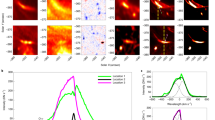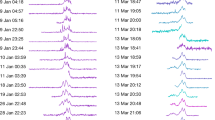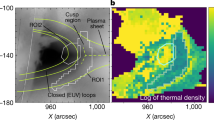Abstract
Comprehensive observations of coronal transients have been made using the OSO 7 (ref. 1), Skylab2–4, Solar Maximum Mission5 and currently Solwind6,7 coronographs. An important question in regard to understanding these transients and their relationship to solar radio burst observations8 and in situ solar wind measurements9 is whether the shock front produced by the disturbances corresponds to the white light front. It has recently been demonstrated10 that spectral broadening measurements of monochromatic spacecraft radio signals represent a useful tool for detecting and studying shocks near the Sun. We now report that a coronal transient observed by the Solwind coronograph off the west limb of the Sun on 24 October 1979 was also seen in the spectral broadening observations of the Helios-2 2.3-GHz radio signal. A comparison of these simultaneous data suggests that in this case the shock front does not coincide with the white-light front but in fact precedes it.
This is a preview of subscription content, access via your institution
Access options
Subscribe to this journal
Receive 51 print issues and online access
$199.00 per year
only $3.90 per issue
Buy this article
- Purchase on Springer Link
- Instant access to full article PDF
Prices may be subject to local taxes which are calculated during checkout
Similar content being viewed by others
References
Howard, R. A. et al. Report UAG, World Data Center A for Solar-Terrestrial Physics (NOAA, Boulder, 1975).
Gosling, J. T. et al. Solar Phys. 48, 389–397 (1976).
Hildner, E. in Study of Traveling Interplanetary Phenomena 1977 (eds Shea, M. A., Smart, D. F. & Wu, S. T.) 3–21 (Reidel, Dordrecht, 1977).
Munro, R. H. et al. Solar Phys. 61, 201–215 (1979).
House, L., Wagner, W. J., Hildner, E., Sawyer, C. & Schmidt, H. U. Astrophys. J. Lett. 244, L117 (1981).
Sheeley, N. R. Jr, Howard, R. A., Koomen, M. J., Michels, D. J. & Poland, A. I. Astrophys. J. Lett. 237, 199–1101 (1980).
Poland, A. I., Howard, R. A., Koomen, M. J., Michels, D. J. & Sheeley, N. R. Jr Solar Phys. 69, 169–175 (1881).
Maxwell, A. & Dryer, M. Solar Phys. 73, 313–329 (1981).
Gosling, J. T. et al. Solar Phys. 40, 439–448 (1975).
Woo, R. & Armstrong, J. W. Nature 292, 608–610 (1981).
Woo, R. & Armstrong, J. W. J. geophys. Res. 84, 7288–7296 (1979).
Armstrong, J. W. & Woo, R. Astr. Astrophys. 103, 415–421 (1981).
Cane, H. V., Stone, R. G. & Woo, R. Geophys. Res. Lett. 9, 897–900 (1982).
Author information
Authors and Affiliations
Rights and permissions
About this article
Cite this article
Woo, R., Armstrong, J., Sheeley, N. et al. Simultaneous radio scattering and white light observations of a coronal transient. Nature 300, 157–159 (1982). https://doi.org/10.1038/300157a0
Received:
Accepted:
Issue Date:
DOI: https://doi.org/10.1038/300157a0
This article is cited by
-
Large-scale solar-wind structure near the Sun detected by Doppler scintillation
Nature (1993)
-
White-light and radio sounding observations of coronal transients
Solar Physics (1985)
Comments
By submitting a comment you agree to abide by our Terms and Community Guidelines. If you find something abusive or that does not comply with our terms or guidelines please flag it as inappropriate.



